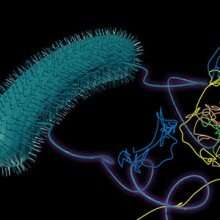Calculating 'run and tumble' behavior of bacteria in groundwater

Bacteria in groundwater move in surprising ways. They can passively ride flowing groundwater, or they can actively move on their own in what scientists call "run and tumble" behavior. However, most numerical models of bacterial transport in groundwater stumble when it comes to calculating how bacteria move. As a first step in improving these models, scientists studied the movements of two kinds of microorganisms. They then factored those characteristics into a simple micro-scale transport model that more accurately predicted changes underground.
Current reactive transport models either do not account for any movement or only simulate passive transport of bacteria in groundwater, which can lead to a poor understanding of bacteria's influence on contaminant transport and nutrient cycling. The results of this study can help scientists develop more accurate numerical models of bacterial transport so they can better understand the role of bacteria in hydro-biogeochemical processes. These results can also help engineers design better approaches for managing contaminant plumes.
Scientists at the Desert Research Institute, Pacific Northwest National Laboratory, Brigham Young University, and EMSL, the Environmental Molecular Sciences Laboratory, partnered to study how two different types of microorganisms moved in flowing groundwater. Both types of microorganisms had been used in contaminant transport studies, one at the Hanford Site in southeastern Washington State and one at the U.S. Department of Energy field research site in Rifle, Colorado. The scientists studied trajectories of individual cells over several seconds to a few minutes. Using EMSL's super resolution fluorescence microscope, they noted a distinct run (movement in one direction) followed by a tumble (a sudden, random change in direction). By calculating the length and timing of these movements, they could develop a simple Continuous Time Random Walk (CTRW) model to predict how the bacteria would move. When compared to current models for bacterial remediation, the CTRW model was better at predicting bacterial transport in many circumstances. The CTRW model is the first step in developing and testing new reactive transport models that incorporate bacterial transport behavior.
More information: Xueke Yang et al. On Modeling Ensemble Transport of Metal Reducing Motile Bacteria, Scientific Reports (2019). DOI: 10.1038/s41598-019-51271-0
Journal information: Scientific Reports
Provided by Environmental Molecular Sciences Laboratory





















